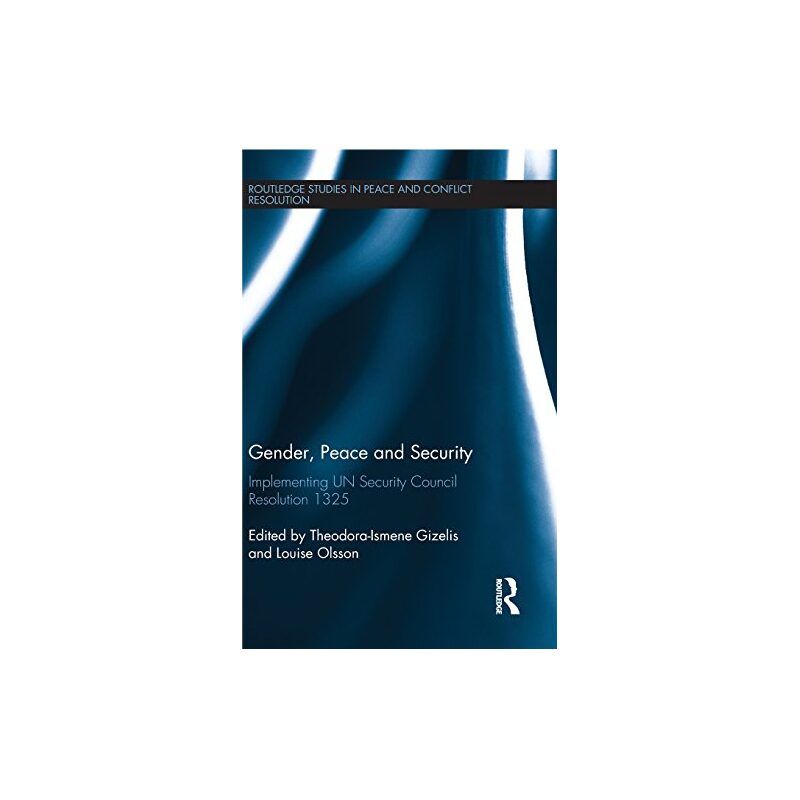The women, peace, and security agenda is often treated as one coherent process when in it is a myriad of questions and challenges each demanding different responses.
The Folke Bernadotte Academy’s Louise Olsson is the co-editor a book entitled Gender, Peace and Security: Implementing UN Security Council resolution 1325. The Global Peace Operations Review’s Lesley Connolly recently asked her how this agenda is moving forward after last year’s three key reports on peace operations, peacebuilding, and resolution 1325 and what the book can tell us about the way forward.
Lesley Connolly: Many books have been written about gender. What does this book contribute to the debate around gender policies in peace operations?
Louise Olsson: While there has been a lot of good policy and critical research, there is still a shortage of systematic empirical, and not least statistical, research that can test assumptions and try to find out what works – and what doesn’t – when we try to realize the resolutions on women, peace and security. The Folke Bernadotte Academy has worked since 2009 to support this form of research by organizing a network called the Research Working Group on 1325. In this book, Gender, Peace and Security: Implementing UN Security Council resolution 1325, my co-editor Ismene Gizelis and I bring together new knowledge from the network and try to move the debate forward.
The book focuses on three themes of the resolution – participation, protection, and gender mainstreaming. It tests some of our assumptions and arguments quite openly. For example, how should we better understand what it takes to increase women’s participation in a peace process? Is it so “easy” as to just focus on ensuring access – or is it about understanding what the different power platforms which underlie participation look like so we can act more strategically? Another example is Ragnhild Nordås and Siri Rustad’s chapter on Sexual Exploitation and Abuse which finds that missions operating in areas with many vulnerable groups are more likely to have personnel commit these crimes. We need more of this form of research if we are to take implementation further and we hope that the book contributes to those efforts.
LC: What are the greatest challenges facing the implementation of Resolution 1325?
LO: As we see in the High Level Panel on Peace Operations (HIPPO) report and the Global Study on Resolution 1325, some of basic challenges remain in how we address the underlying reasons for why the resolution was adopted in October 2000. Since then, we have come further in understanding that women and men are differently affected by conflict, how we see women as actors, and we know that peace automatically does not mean the same for men and women. But we still have far to go in terms of understanding how to best adapt to these facts in a systematic and effective manner. To address this, the reports suggest that the Security Council should receive an improved form of conflict analysis that includes a more explicit gender perspective.
Other challenges lie in how we have approached implementation. The HIPPO report talks about the need for a stronger leadership responsibility. We need to get this firmly integrated through the chain of command. We are not there yet.
However, as Ismene and I also note in a blog on Political Violence a few months ago, the Women, Peace and Security (WPS) agenda today encompasses most issues and themes on the whole of the Security Council’s vast agenda. Still, we often treat WPS as one coherent process. This is in itself presents a challenge. WPS now consists of a myriad of questions and problems which require different forms of actions and competences in order to be effectively addressed – each in their own fashion.
LC: How do we start to overcome these challenges and start progressing the women, peace, and security agenda? Will the recommendation on senior gender advisers help?
LO: Perhaps it is time to get even more strategic in how we address the different questions and challenges on the vast WPS agenda. As an example, it is important not to mix up gender mainstreaming with women’s participation in peace operations, or to mix it up with women’s participation in peace negotiations. These are three distinct areas with their own challenges. The first is about mandate delivery – does an operation contribute to a more equal peace? The second is about recruitment and equal opportunities. The third is about a more inclusive peace process. All are very important but in order to be successful, we have to address them as separate challenges – although they all require a better understanding of gender equality dynamics. To address them, we need to make use of the increasing empirical evidence and systematic research that is now quickly growing in all areas as we can see in the book.
A more strategic approach needs assistance by a senior gender adviser as outlined in the Secretary-General’s report following up on the Global Study. This decision is not unique to the UN. In NATO, the recommendation has long been that the gender adviser should be placed directly in relation to the most senior management. Gender mainstreaming is essentially about understanding how to turn the main mandate into action – which is a leadership responsibility. In order to be able to do that in a way which benefits men and women, and which contributes positively to a country’s gender equality developments, he or she needs support from a gender adviser.
LC: How does this book resonate with the findings of the Global Study?
LO: The book was published ahead of the study so it does not address the results directly, but there are many common denominators with the recommendations from both the study and the HIPPO report.
Ismene Gizelis and Jana Krause’s chapter finds that we need to get even better at ironing out how to more effectively adapt to both men’s and women’s situations and security needs, i.e. how to get functioning gender mainstreaming in place. This requires a solid understanding of each given context. The same is true for funding and inclusion of women’s local participation which must be specific to the given setting.
Gender Mainstreaming is Essentially About Understanding How to Turn the Main Mandate Into Action – Which is a Leadership Responsibility.
The chapter by Helen Basini is a good example of this problematique in a DDR context. She finds that in Liberia, women were part of demobilization and demilitarization phases but that a similar inclusion did not occur in the reintegration phase. This, she argues, demonstrates the importance of also having a clear and concrete understanding of the situation for both men and women in the transition process from peacekeeping to peacebuilding, which was addressed by both HIPPO and the peacebuilding review.
LC: In both the HIPPO and Peacebuilding Architecture reports there are recommendations looking at leadership and the need for more gender balanced representation within peace operations. How does your book address this recommendation?
LO: The book provides insights into the many challenges that come with working to improve participation in peace operations. Sabrina Karim and Kyle Beardsley examine the reasons for why it is so difficult to increase the number of women in uniform and find that the incentives of the contributing countries are central. However, they also warn us from making oversimplified solutions focusing on numbers. First of all, working to increase the number of women personnel requires strong leadership that seeks to change and improve the working environment and to rid the organization of negative gender stereotypes. Second, we need to understand that having, for example, twenty per cent women employees does not mean that we automatically have a gender perspective.
LC: We have just seen the appointment of Elizabeth Spehar as Special Representative in Cyprus and Lisa Buttenheim as Deputy of the Department of Field Support, but women are under represented in the senior ranks of the UN Secretariat. Where is the problem and how do we overcome this gap?
LO: This is an additional important theme under the WPS agenda that needs to be more strongly addressed in its own right. While we have not looked at that specific issue in the book, there is quite a lot of growing research – and many lessons learned from other spheres – which shows that it can be addressed successfully if there is will. It is also a question which was much discussed already when I started doing research on WPS in 1999, so it is disturbing that we have not come further.
LC: It has been acknowledged that 1325 has not yet been implemented fully; now we have the Global Study that has this provided renewed focus on gender issues. How do we ensure a sustained focus on the WPS agenda?
LO: We need to become more specific in how we measure our progress on addressing the different problems and questions that fall under the implementation of the resolutions. We have made progress in many areas which we need to recognize and build on in our continued work. We will discuss this and how to support progress further at the Challenges Forum 20th anniversary meeting on 8-9 May here in New York. [Download Louise Olsson’s background paper for this event Leading the Way to a More Equal Peace: Senior Management and Gender Mainstreaming from GPOR’s related document library.]
I also think that gender mainstreaming needs to be more strategically channeled into the major processes and big questions facing the UN around prevention and the changing nature of conflict. Much depends on how the next Secretary-General, regardless of whether it is a male or female, addresses the challenges recognized in the resolutions on women, peace and security and in the Convention on the Elimination of All forms of Discrimination against Women (CEDAW).
So far, we have seen less focus on the Global Study and the gender specific recommendations of the HIPPO report. Unless we all take this seriously, there is a risk that we will not see the progress which is much needed.
LC: Who is the target audience of this book and what message do you aim to get out there with this book?
LO: The target audience is both policy makers and researchers; those interested in WPS questions but also those focusing more broadly on peace and security. The aim is twofold: bring out new and central lessons learned which can assist us in progressing the implementation of resolution 1325 in the areas of participation, protection and gender mainstreaming. The other is to demonstrate what systematic research can contribute with in terms of bringing us more and nuanced knowledge on how the UN can continue to contribute to a more equal peace.
Louise Olsson is Senior Advisor on Gender, Peace, and Security at the Folke Bernadotte Academy. Twitter: @LouiseKOlsson
Lesley Connolly is a Research Assistant at the Center on International Cooperation.



